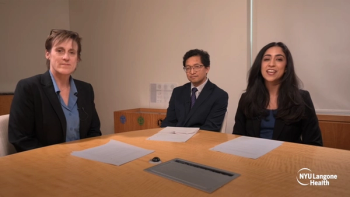
Evaluating and treating tear film patients with success
Cynthia Matossian, MD, FACS, explains why she believes if ophthalmologists consistently evaluate the ocular surface, tear film and lid margins—and treat any problems that we find—surgical outcomes will improve.
I firmly believe that if we consistently evaluate the ocular surface, tear film and lid margins—and treat any problems that we find—surgical outcomes will improve.
Previously by Dr. Matossian:
There is evidence to support this. Along with several other colleagues, Alice Epitropoulos, MD, and I reported that patients with elevated tear osmolarity have significantly more variability in average K readings and anterior corneal astigmatism than those with normal osmolarity.1
In published research, I have shown that astigmatism varies unpredictably in patients with meibomian gland dysfunction (MGD)—so unpredictably, in fact, that treating patients with MGD with thermal pulsation therapy (LipiFlow, Johnson & Johnson Vision) can result in significantly lower residual refractive error after surgery.2
Where this concept too often fails is with the very first part—“evaluate.”
Surgeons don’t find what we don’t look for. Many busy ophthalmologists perceive that evaluating surgical patients for ocular surface disease will be too burdensome—that it will add time to patient throughput.
But that need not be the case.
Related:
Ocular surface evaluation can be quick and inexpensive, with the most basic evaluation requiring little more than a staff-administered symptom questionnaire, a slit lamp and some vital dyes.
Symptom questionnaires are an excellent starting point to assess how common dry eye symptoms are in your patient population. Even if patients don’t complain of the classic dry eye symptoms, fluctuations in vision can point to a poor-quality tear film and MGD.
Right now, patients are experiencing these symptoms more than ever. Thanks to COVID-19, all of us are spending more time online and staring at screens.
Activities that used to be social and in-person—like conferences, book clubs or happy hour—have all moved online.
People are bored at home and binge-watching shows instead of going out for dinner. All of this screen-based activity slows down the blink rate and exacerbates pre-existing dry eye disease (DED) or MGD.
Related:
If you do nothing else, start with a questionnaire and see what you find.
As many as 50% of patients with DED or MGD are asymptomatic. Therefore, looking for tell-tale signs at the slit lamp is key.
In my next blog post, I’ll go into more detail about the different dry eye protocols, what to add next, and how to improve your ocular surface evaluation in a way that makes sense—both logistically and financially.
---
Cynthia Matossian, MD, FACS
Dr. Matossian is the founder and medical director of Matossian Eye Associates, Pennsylvania and New Jersey; adjunct clinical instructor at Temple University School of Medicine, Philadelphia.
References
1. Epitropoulos AT, Matossian C, Berdy GJ, et al. Effect of tear osmolarity on repeatability of keratometry for cataract surgery planning. J Cataract Refract Surg. 2015;41(8):1672-7.
2.Matossian C. Impact of thermal pulsation treatment on astigmatism management and outcomes in meibomian gland dysfunction patients undergoing cataract surgery. Clin Ophth 2020.
Newsletter
Don’t miss out—get Ophthalmology Times updates on the latest clinical advancements and expert interviews, straight to your inbox.













































